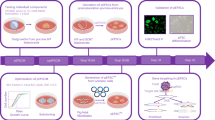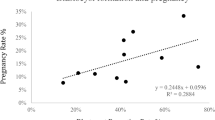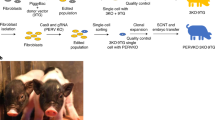Abstract
Here we describe a procedure for cloning pigs by the use of in vitro culture systems. Four healthy male piglets from two litters were born following nuclear transfer of cultured somatic cells and subsequent embryo transfer. The initiation of five additional pregnancies demonstrates the reproducibility of this procedure. Its important features include extended in vitro culture of fetal cells preceding nuclear transfer, as well as in vitro maturation and activation of oocytes and in vitro embryo culture. The cell culture and nuclear transfer techniques described here should allow the use of genetic modification procedures to produce tissues and organs from cloned pigs with reduced immunogenicity for use in xenotransplantation.
This is a preview of subscription content, access via your institution
Access options
Subscribe to this journal
Receive 12 print issues and online access
$209.00 per year
only $17.42 per issue
Buy this article
- Purchase on Springer Link
- Instant access to full article PDF
Prices may be subject to local taxes which are calculated during checkout



Similar content being viewed by others
References
Campbell, K.H., McWhir, J., Ritchie, W.A. & Wilmut, I. Sheep cloned by nuclear transfer from a cultured cell line. Nature 380, 64–66 (1996).
Wilmut, I., Schnieke, A.E., McWhir, J., Kind, A.J. & Campbell, K.H. Viable offspring derived from fetal and adult mammalian cells. Nature 385, 810–813 (1997).
Cibelli, J.B. et al. Cloned transgenic calves produced from nonquiescent fetal fibroblasts. Science 280, 1256–1258 (1998).
Wells, D.N., Misica, P.M. & Tervit, H.R. Production of cloned calves following nuclear transfer with cultured adult mural granulosa cells. Biol. Reprod. 60, 996–1005 (1999).
Baguisi, A. et al. Production of goats by somatic cell nuclear transfer. Nat. Biotechnol. 17, 456–461 (1999).
Wakayama, T., Perry, A.C., Zuccotti, M., Johnson, K.R. & Yanagimachi, R. Full-term development of mice from enucleated oocytes injected with cumulus cell nuclei. Nature 394, 369–374 (1998).
Prather, R.S., Sims, M.M. & First, N.L. Nuclear transplantation in early pig embryos. Biol. Reprod. 41, 414–418 (1989).
Prather, R.S., Tao, T. & Machaty, Z. Development of the techniques for nuclear transfer in pigs. Theriogenology 51, 487–498 (1999).
Hazeleger, W. & Kemp, B. State of the art in pig embryo transfer. Theriogenology 51, 81–90 (1999).
Niemann, H. & Kues, W.A. Transgenic livestock: premises and promises. Anim. Reprod. Sci. 60–61, 277–293 (2000).
Tao, T., Machaty, Z., Abeydeera, L.R., Day, B.N. & Prather, R.S. Optimisation of porcine oocyte activation following nuclear transfer. Zygote 8, 69–77 (2000).
Polejaeva, I.A. et al. Cloned pigs produced by nuclear transfer from adult somatic cells. Nature 407, 505–509 (2000).
Onishi, A. et al. Pig cloning by microinjection of fetal fibroblast nuclei. Science 289, 1188–1190 (2000).
Cozzi, E., Masroor, S., Soin, B., Vial, C. & White, D.J. Progress in xenotransplantation. Clin. Nephrol. 53, 13–18 (2000).
Cozzi, E. & White, D.J. The generation of transgenic pigs as potential organ donors for humans. Nat. Med. 1, 964–966 (1995).
Joziasse, D.H. & Oriol, R. Xenotransplantation: the importance of the Galalpha1,3Gal epitope in hyperacute vascular rejection. Biochim. Biophys. Acta 1455, 403–418 (1999).
Thompson, S., Clarke, A.R., Pow, A.M., Hooper, M.L. & Melton, D.W. Germ line transmission and expression of a corrected HPRT gene produced by gene targeting in embryonic stem cells. Cell 56, 313–321 (1989).
Mueller, S. et al. Chimeric pigs following blastocyst injection of transgenic porcine primordial germ cells. Mol. Reprod. Dev. 54, 244–254 (1999).
Piedrahita, J.A. Targeted modification of the domestic animal genome. Theriogenology 53, 105–116 (2000).
McCreath, K.J. et al. Production of gene-targeted sheep by nuclear transfer from cultured somatic cells. Nature 405, 1066–1069 (2000).
Lanza, R.P. et al. Extension of cell life-span and telomere length in animals cloned from senescent somatic cells. Science 288, 665–669 (2000).
Gordon, I.R. Controlled reproduction in pigs. (CAB International, Wallingford, Oxon, UK, New York, NY; 1997).
Hunter, R.H. Chronological and cytological details of fertilization and early embryonic development in the domestic pig, Sus scrofa. Anat. Rec. 178, 169–185 (1974).
Papaioannou, V.E. & Ebert, K.M. The preimplantation pig embryo: cell number and allocation to trophectoderm and inner cell mass of the blastocyst in vivo and in vitro. Development 102, 793–803 (1988).
Polge, C., Rowson, L.E. & Chang, M.C. The effect of reducing the number of embryos during early stages of gestation on the maintenance of pregnancy in the pig. J. Reprod. Fertil. 12, 395–397 (1966).
Saito, S. & Niemann, H. Effects of extracellular matrices and growth factors on the development of isolated porcine blastomeres. Biol. Reprod. 44, 927–936 (1991).
Reichelt, B. & Niemann, H. Generation of identical twin piglets following bisection of embryos at the morula and blastocyst stage. J. Reprod. Fertil. 100, 163–172 (1994).
Tao, T., Reichelt, B. & Niemann, H. Ratio of inner cell mass and trophoblastic cells in demi- and intact pig embryos. J. Reprod. Fertil. 104, 251–258 (1995).
Susko-Parrish, J.L., Leibfried-Rutledge, M.L., Northey, D.L., Schutzkus, V. & First, N.L. Inhibition of protein kinases after an induced calcium transient causes transition of bovine oocytes to embryonic cycles without meiotic completion. Dev. Biol. 166, 729–739 (1994).
Strelchenko, N.S., Betthauser, J.M., Jurgella, G.L., Pace, M.P. & Bishop, M.D. Method of cloning bovines using reprogrammed non-embryonic bovine cells. US 6,011,197 (2000).
Dalmasso, A.P., Vercellotti, G.M., Platt, J.L. & Bach, F.H. Inhibition of complement-mediated endothelial cell cytotoxicity by decay-accelerating factor. Potential for prevention of xenograft hyperacute rejection. Transplantation 52, 530–533 (1991).
Bhatti, F.N. et al. Three-month survival of HDAFF transgenic pig hearts transplanted into primates. Transplant. Proc. 31, 958 (1999).
Petters, R.M. & Wells, K.D. Culture of pig embryos. J. Reprod. Fertil. Suppl. 48, 61–73 (1993).
Yoshida, M., Ishigaki, K., Nagai, T., Chikyu, M. & Pursel, V.G. Glutathione concentration during maturation and after fertilization in pig oocytes: relevance to the ability of oocytes to form male pronucleus. Biol. Reprod. 49, 89–94 (1993).
Grupen, C.G., Nagashima, H. & Nottle, M.B. Role of epidermal growth factor and insulin-like growth factor-I on porcine oocyte maturation and embryonic development in vitro. Reprod. Fertil. Dev. 9, 571–575 (1997).
Naito, K., Fukuda, Y. & Toyoda, Y. Effects of porcine follicular fluid on male pronucleus formation in porcine oocytes matured in vitro. Gamete Res. 21, 289–295 (1988).
Funahashi, H., Cantley, T.C. & Day, B.N. Synchronization of meiosis in porcine oocytes by exposure to dibutyryl cyclic adenosine monophosphate improves developmental competence following in vitro fertilization. Biol. Reprod. 57, 49–53 (1997).
Funahashi, H. & Day, B.N. Effects of the duration of exposure to hormone supplements on cytoplasmic maturation of pig oocytes in vitro. J. Reprod. Fertil. 98, 179–185 (1993).
Rosenkrans, C.F.J. & First, N.L. Culture of bovine zygotes to the blastocyst stage: effects of amino acids and vitamins. Theriogenology 35, 266 (1991).
Long, C.R., Dobrinsky, J.R. & Johnson, L.A. In vitro production of pig embryos: comparisons of culture media and boars. Theriogenology 51, 1375–1390 (1999).
Grupen, C.G. & Nottle, M.B. A simple modification of the in vitro fertilization procedure improves the efficiency of in vitro pig embryo production. Theriogenology 53, 422 (2000).
Rath, D., Johnson, L., Dobrinsky, J., Welch, G. & Niemann, H. Production of piglets preselected for sex following in vitro fertilization with X and Y chromosome-bearing spermatozoa sorted by flow cytometry. Theriogenology 47, 795–800 (1997).
USDA supported U.S. Pig Genome Project, http://sol.marc.usda.gov/genome/swine/
Acknowledgements
We would like to acknowledge Drs. Neal First and Tom Crenshaw of the University of Wisconsin, Madison, for their assistance in coordinating porcine embryo transfer at the University of Wisconsin Swine Research Facility and Dr. Matthew Wheeler of the University of Illinois, Champagne-Urbana, for discussions on porcine reproduction. We would also like to thank Dr. Heiner Niemann of the Institut für Tierzucht und Tierverhalten, Neustadt, Germany, for discussions on embryo transfer, and Dr. Max F. Rothschild of the US Pig Genome Project, Iowa State University, for the kind gift of porcine microsatellite markers.
Author information
Authors and Affiliations
Corresponding author
Rights and permissions
About this article
Cite this article
Betthauser, J., Forsberg, E., Augenstein, M. et al. Production of cloned pigs from in vitro systems. Nat Biotechnol 18, 1055–1059 (2000). https://doi.org/10.1038/80242
Received:
Accepted:
Issue Date:
DOI: https://doi.org/10.1038/80242
This article is cited by
-
Generation of goats by nuclear transfer: a retrospective analysis of a commercial operation (1998–2010)
Transgenic Research (2020)
-
Application of new biotechnologies for improvements in swine nutrition and pork production
Journal of Animal Science and Biotechnology (2019)
-
Roadblocks in the Path of iPSC to the Clinic
Current Transplantation Reports (2018)
-
Choosing a culture medium for SCNT and iSCNT reconstructed embryos: from domestic to wildlife species
Journal of Animal Science and Technology (2017)
-
Successful cloning of an adult breeding boar from the novel Chinese Guike No. 1 swine specialized strain
3 Biotech (2016)



